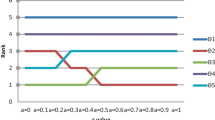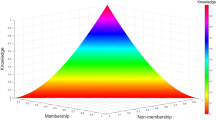Abstract
The present article provides a new technique using extended VIKOR–TODIM and entropy measures for Intuitionistic Fuzzy Sets (IFSs). First, we developed a new entropy information measure for IFSs and talked about their limiting cases. The performance of the proposed information measure has been validated with the help of TODIM (An acronym in Portuguese for Interactive and Multi-criteria Decision-Making) and VIKOR (vlseKriterijumska Optimizacija I Kompromisno Resenje) methods. We combined the VIKOR–TODIM method based on weights criteria to solve the multi-criteria decision-making (MCDM) problems. Firstly, the problem with multi-criteria decision-making is designed and the steps, principles of the proposed VIKOR–TODIM method are presented. Finally, to verify the applicability of the proposed approach, a decision-making problem is presented. Then the evaluation of the software companies alternatives against each criterion is explored in terms of Intuitionistic Fuzzy Numbers (IFNs). The proposed VIKOR–TODIM model is an effective tool to evaluate and select the best choice for a software company as compared to existing methods.
Access this chapter
Tax calculation will be finalised at checkout
Purchases are for personal use only
Similar content being viewed by others
References
Zadeh LA (1965) Fuzzy sets. Inf Control 8:338–353
DeLuca A, Termini SA (1972) Definition of non-probabilistic entropy in the setting of fuzzy set theory. Inf Control 20:301–312
Yager RR (1979) On the measure of fuzziness and negation part I: membership in the unit interval. I J Gen Syst 5(4):221–229
Higashi M, Klir G (1982) On measures of fuzziness and fuzzy complements. Int J of Gen Syst 8:169–180
Atanassov KT (1986) Intuitionistic fuzzy sets. Fuzzy Sets Syst 20(1):87–96
Szmidt E, Kacprzyk J (2001) Entropy for intuitionistic fuzzy sets. Fuzzy Sets Syst 118(3):467–477
Hung WL, Yang MS (2006) Fuzzy entropy on intuitionistic fuzzy sets. Int J Intell Syst 21(4):443–451
Tugrul F, Gezercan M, Citil M (2017) Application of intuitionistic fuzzy set in high school determination via normalized euclidean distance method. Notes Intuitionistic Fuzzy Sets 23(1):42–47
Liu HC, You JX, Duan CY (2019) An integrated approach for failure mode and effect analysis under interval-valued intuitionistic fuzzy environment. Int J Prod Econ 207:163–172
Chen CC (2019) A new multicriteria assessment model combining GRA techniques with intuitionistic fuzzy entropy based TOPSIS method for sustainable building materials supplier selection. Sustainability 11(8):2265
Jiang Q, Jin X, Lee SJ, Yao S (2019) A new similarity/distance measure between intuitionistic fuzzy sets based on the transformed isosceles triangles and its applications to pattern recognition. Expert Syst Appl 116:439–453
Joshi R, Kumar S (2018) An intuitionistic fuzzy \((\delta,\gamma )\)-norm entropy with its application in supplier selection problem. Comput Appl Math 37(5):5624–5649
Opricovic S (1998) Multicriteria optimization of civil engineering systems. Facultyu of Civil Engineering, Belgrade
Hwang CL, Yoon K (1981) Multiple attribute decision making: methods and applications. Springer, Berlin
Gomes L, Rangel L (2009) An application of the TODIM method to the multicriteria rental evaluation of residential properties. Eur J Oper Res 193:204–211
Kahneman D, Tversky A (1979) Prospect theory: an analysis of decision under risk. Econometrica 47(2):263–292
Yazdani M, Chatterjee P, Zavadskas EK, Hashemkhani ZS (2016) Integrated QFD-MCDM framework for green supplier selection. J Clean Prod 142:3728–3740
Chen SM, Tan JM (1994) Handling multi-criteria fuzzy decision-making problems based on vague set theory. Fuzzy Sets Syst 67:163–172
Hong DH, Choi CH (2000) Multi-criteria fuzzy decision-making problems based on vague set theory. Fuzzy Sets Syst 114:103–113
Szmidt E, Kacprzyk J, Bujnowski P (2014) How to measure amount of knowledge conveyed by Atanassov’s intuitionistic fuzzy sets. Inf Sci 7:276–285
Zadeh LA (1968) Probability measures of fuzzy events. J Math Anal Appl 23(2):421–427
Shannon CE (1948) The mathematical theory of communication. Bell Syst Tech J 27(3):379–423
Bhandari D, Pal NR (1993) Some new information measures for fuzzy sets. Inf Sci 67(3):204–228
Renyi A (1961) On measures of entropy and information. In: Proceedings of the 4th Barkley symposium on mathemtaical statistics and probability, vol 1. University of California Press, p 547
Vlachos IK, Sergiadis GD (2007) Intuitionistic fuzzy information: applications to pattern recognition. Pattern Recogn Lett 28(2):197–206
Arya V, Kumar S (2020) Fuzzy entropy measure with an applications in decision making under bipolar fuzzy environment based on TOPSIS method. Int J Inf Manag Sci (In press)
Yu PL (1973) A class of solutions for group decision problems. Manage Sci 19(8):936–946
Xu ZS, Hu H (2010) Projection models for intuitionistic fuzzy multiple attribute decision making. Int J Inf Tech Decis Making 9(2):267–280
Boran FE, Genc S, Akay D (2011) Personnel selection based on intuitionistic fuzzy sets. In: Human factors and ergonomics in manufacturing and service industries, vol 21, no 5, pp 493–503
You XY, Liu HC (2017) An extended VIKOR method using intuitionistic fuzzy sets and combination weights for supplier selection. Symmetry 9(9):169
Author information
Authors and Affiliations
Corresponding author
Editor information
Editors and Affiliations
Rights and permissions
Copyright information
© 2021 Springer Nature Singapore Pte Ltd.
About this paper
Cite this paper
Arya, V., Kumar, S. (2021). Extended VIKOR–TODIM Approach Based on Entropy Weight for Intuitionistic Fuzzy Sets. In: Singh, P., Gupta, R.K., Ray, K., Bandyopadhyay, A. (eds) Proceedings of International Conference on Trends in Computational and Cognitive Engineering. Advances in Intelligent Systems and Computing, vol 1169. Springer, Singapore. https://doi.org/10.1007/978-981-15-5414-8_7
Download citation
DOI: https://doi.org/10.1007/978-981-15-5414-8_7
Published:
Publisher Name: Springer, Singapore
Print ISBN: 978-981-15-5413-1
Online ISBN: 978-981-15-5414-8
eBook Packages: Intelligent Technologies and RoboticsIntelligent Technologies and Robotics (R0)




